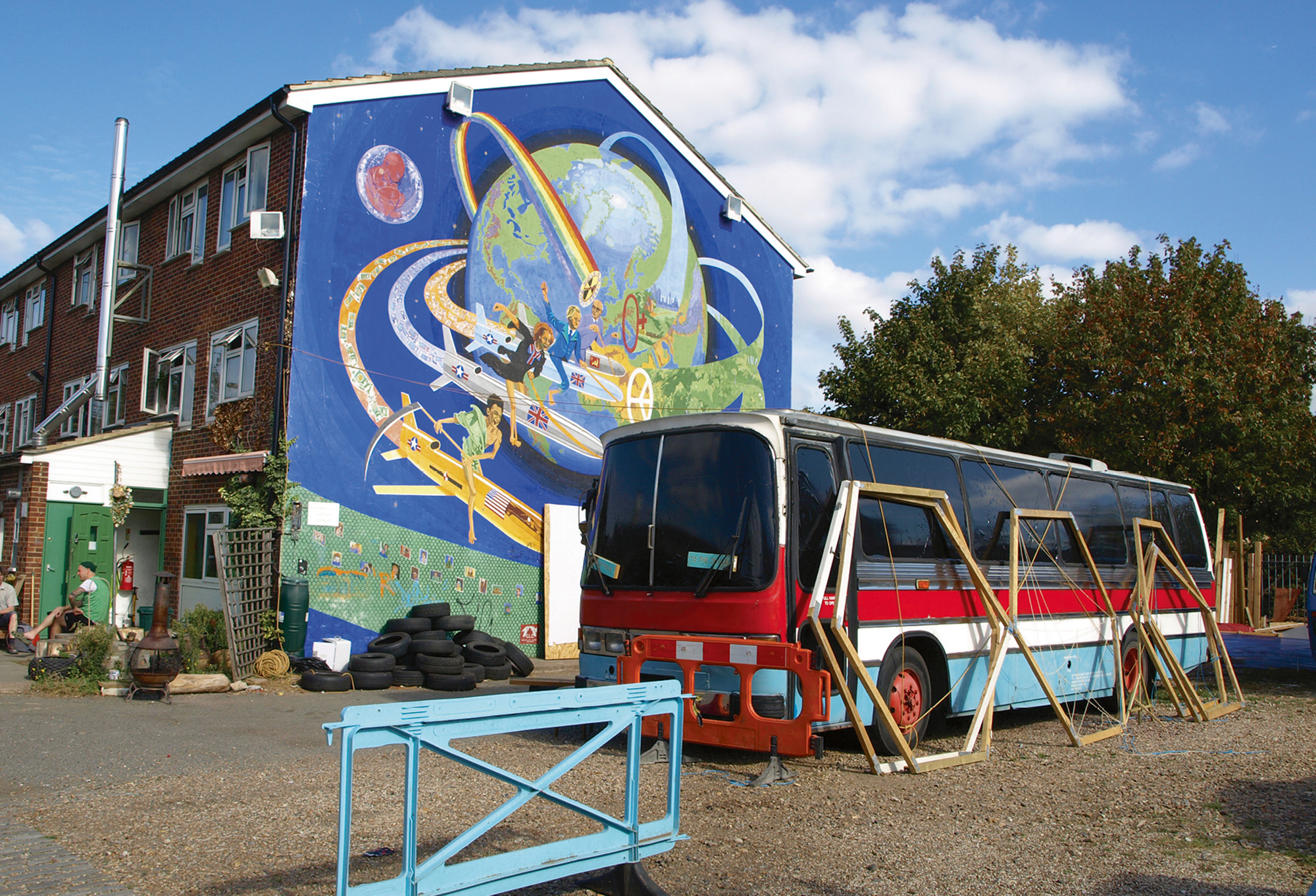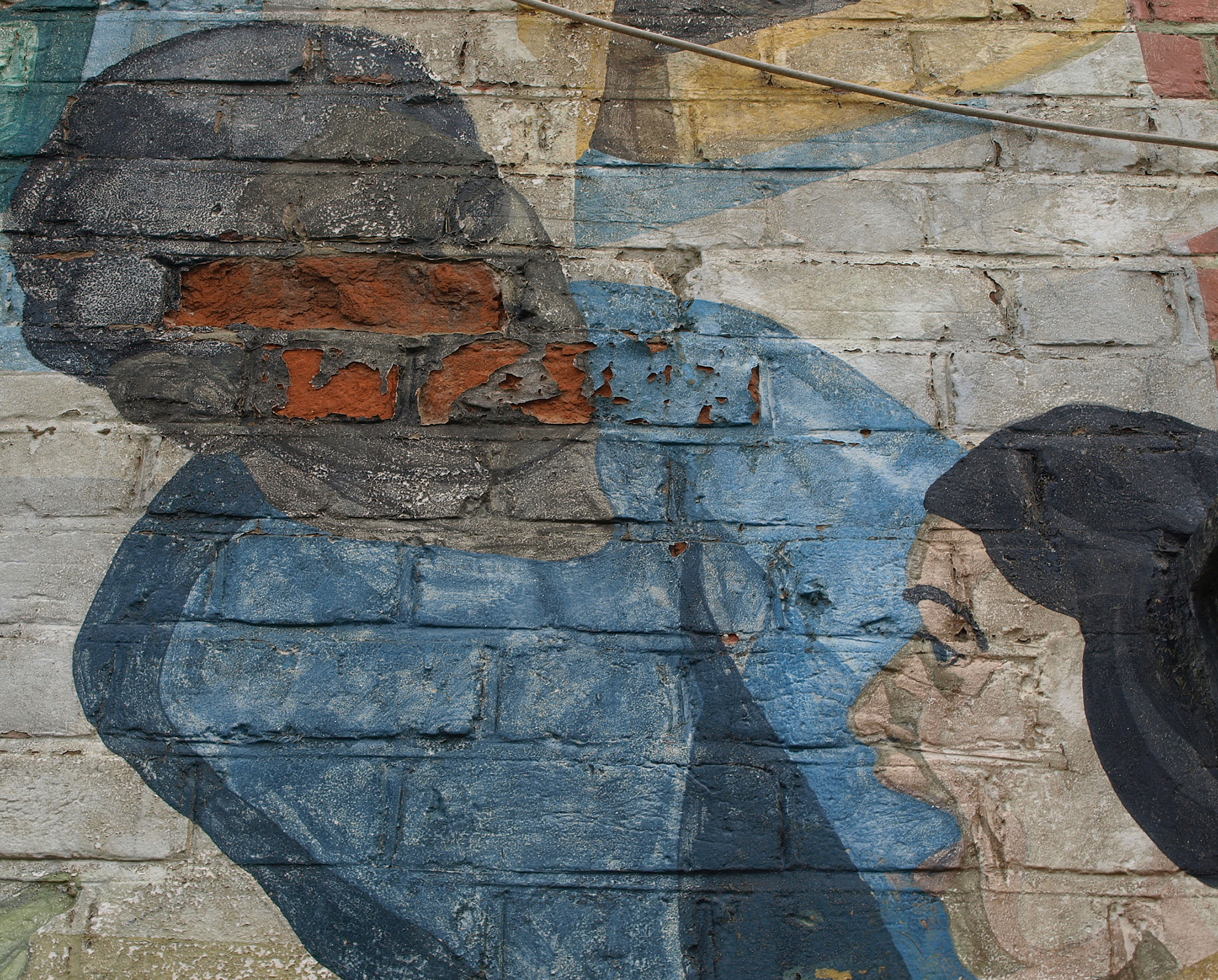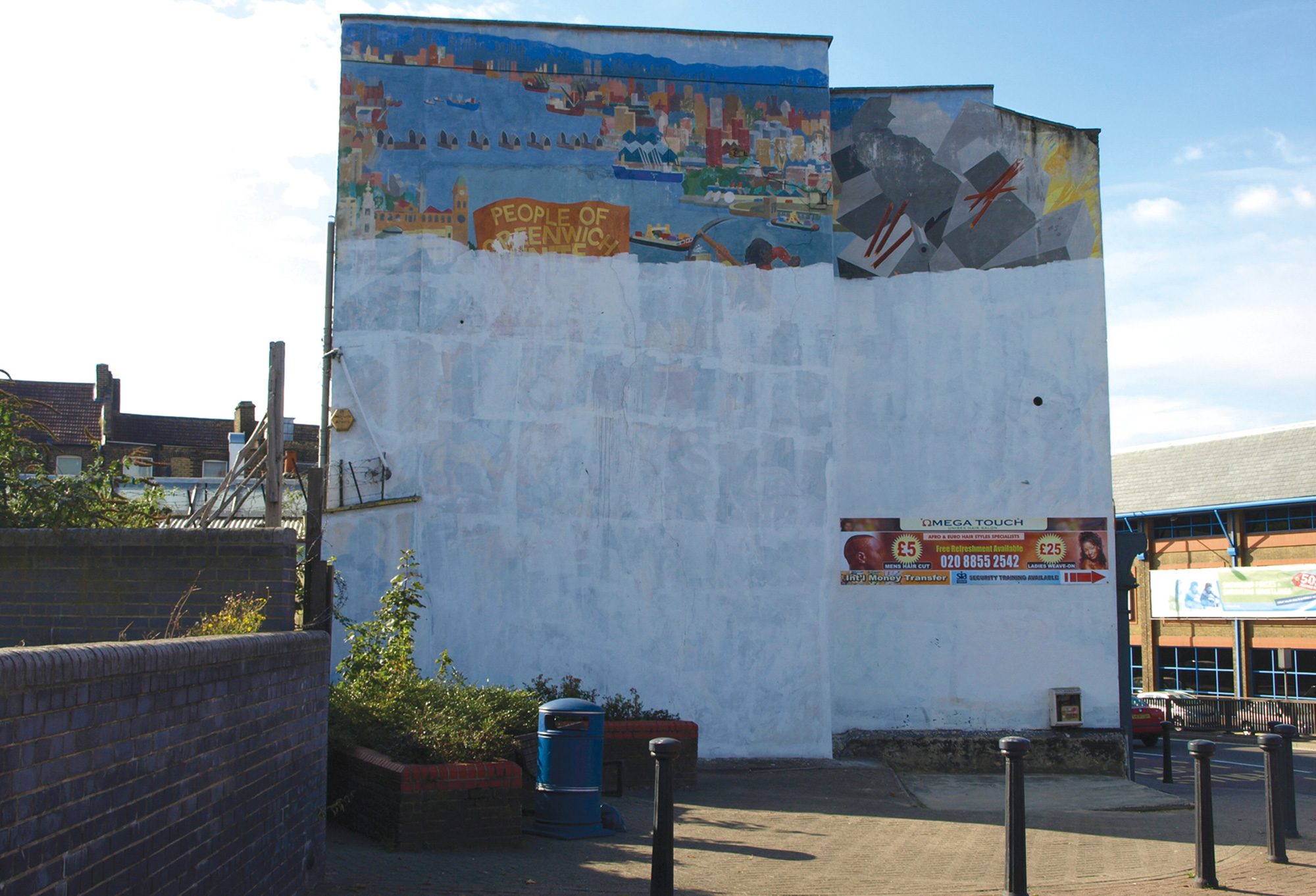Changing the Pictures
What’s left of London’s political murals
Owen Hatherley

London is a mercantile city, a colonial city, and a place whose radical history is easily suppressed. You can walk past a particular object a thousand times without really noticing just how strange and jarring it actually is, how uneasily it sits with the desperately accumulating city all around. Not far from where I live in southeast London is a painting on the wall of a public housing complex built between the wars. It’s somewhat faded, and placed behind a school playground just by the traffic-and-Tex-Mex-emporia-clogged UNESCO World Heritage Site that is “Maritime Greenwich.” The mural has little to do with the area, and its glorious imperial past. Rather, we see an insurgent crowd, the word Co-Operativa, some Mesoamerican characters, and, about to be crushed under a gigantic roll of canvas, oil refineries and sundry reactionaries. In the corner is the name “EL SALVADOR.” This is Changing the Picture, a mural by Jane Gifford, Sergio Navarro, Nick Cuttermole, and Rosie Skaife D’Ingerthorpe. Painted in 1985, it was in celebration of the Salvadorian insurgents who were at that point being fought by a CIA-funded military government. The picture, its colors weathered to dun blues and browns, with tenants’ satellite dishes protruding at the corners, places itself squarely in the tradition of the Mexican muralists—Rivera, Orozco, Siqueiros. Heroic workers and peasants, their bodies distorted but never abstracted, occupy an unreal but easily understandable space, heavily symbolic but not esoteric. But what on earth is this mural doing here? Public art is supposed to be either sententiously mysterious (there’s a Gormley half-a-mile away) or a grinningly optimistic symbol of “regeneration”—but not didactic, not concerned with complex political struggles in far-away countries.
Changing the Picture was one of several large-scale murals created in the late 1970s and especially in the early to mid-1980s in the British capital. It was produced partly under the auspices and with the funding of the local authorities characterized by the tabloids of the time as the “loony left,” most of all the Greater London Council (GLC), which for a few years in the 1980s became such a threat to the Conservative government of the United Kingdom that London became the only major world capital without its own governing body. Said tabloids were often keen to point out the alleged profligacy of these councils, which doled out taxpayers’ money to various political and cultural projects. Yet this GLC, unlike its precursor the London County Council, did not (for financial and political reasons) leave a legacy of great public buildings, or of social housing estates. Its presence can be seen in these murals more than anywhere else—their naiveté, earnestness, daring, and enthusiasm speak for the politics of the time. Although some of these, such as the “GLC Peace Murals,” were directly commissioned, more of them came from groups like the Greenwich Mural Workshop, an influential (and still extant) group that left this borough with one of the most impressive, if most poorly treated, legacies of this all-but-forgotten public art.
There are a few antecedents for this peculiar outbreak of fantastical socialist realism on London’s streets. Inside the Marx Memorial Library in Clerkenwell is a 1935 mural by Jack (or rather Viscount) Hastings depicting a burly British worker presiding over a transfigured world, flanked by the figures of Marx, Lenin (who used to work in the same building), and William Morris, and produced contemporaneously with its Mexican and Works Progress Administration sources—but this is safely indoors. Despite their public presence, however, the only one of the 1980s murals to have achieved any major fame is The Battle of Cable Street, painted by Dave Binnington, Paul Butler, Des Rochfort, and Ray Walker. Here, the “battle”—where working-class Eastenders and socialist activists prevented a Fascist march from entering Jewish areas—is commemorated by an explosive mass of fighting figures and banners in a cracked, panoramic perspective packed with surrealistic details like an underwear-clad Hitler thrown aside by a marcher. Some fame clings to the Hackney Peace Carnival Mural in Dalston, painted by Ray Walker, Anna Walker, and Mick Jones—perhaps because, if looked at casually, it depicts a jolly carnivalesque multiracial crowd of the sort that no longer seems threatening to local power, although if examined more closely, the paraphernalia of 1980s leftism is all present—Communist Party and trade union banners, GLC “jobs not bombs” balloons, the slogan “Nuclear Free Zone.”

Yet these are not the only intriguing examples in the city. The first of the murals I was ever really struck by was Brian Barnes’s 1984 New Cross Peace Mural, a.k.a. “The Riders of the Apocalypse,” part of the same series as the work in Dalston. It sits at the end of the non-descript row of 1980s council houses that makes up one of London’s few surviving housing co-operatives. The 1970s and 1980s saw a return to a modest “vernacular” architecture after the modernist ambition of the London County Council’s housing, but the sobriety and lack of imagination of the houses only makes the mural all the more strange and extraordinary, not least because of its necessarily dated (because topical) political import. Here, a series of figures—British Conservative politician Michael Heseltine, Ronald Reagan, a particularly kamikaze-looking Margaret Thatcher, and Yuri Andropov, one of the geriatrics who briefly led the USSR between Brezhnev and Gorbachev—are straddling missiles whizzing around a globe, while counter-missiles, bringing in their train green fields, are zooming didactically towards the forces of imperialism and capitalism. In this perpetually hungover corner of southeast London, surrounded by industrial estates and railway lines, it speaks clunkily but brightly and enthusiastically of a time when Londoners were actively political, as they still are in the housing co-ops—a radicalism in recent memory, rather than a heritage leftism of the 1930s.
There is a particular cluster of surviving and deceased murals in the area of London in which I live, the Borough of Greenwich, the home of the Greenwich Mural Workshop, founded in 1975 by Carol Kenna, Stephen Lobb, Rick Walker, and others. Kenna still runs the workshop, which continues to produce public art in the area, though of a less immediately political sort. She recalls being inspired by the work of the Chicago muralist Bill Walker on a visit to the United States, and aimed to produce something similar in London—a kind of public art that had little to do with “fine art.” In response to other more participatory movements, it was “very deliberately tied in with political movements over workers’ control, community architecture and planning, health, tenants’ rights,” says Kenna, an attempt to inspire people to take control over their environment. So the art was necessarily simplified, in order to make it easy for locals to produce the murals. As many as twelve people would work on a mural at any one time, meaning that the communities it commemorated were directly involved—the workshop would, early on, advertise itself to tenants’ and residents’ associations, seemingly as a self-mythologizing service. The results bore little resemblance to the public art of the 1960s, the Henry Moores, Barbara Hepworths, and second-rate imitations of these that were enigmatically attached to public buildings. Instead, the murals offered something more immediately interventionist. At the same time that they turned formally to figuration, their rhetoric echoed that of Russian Constructivism: Kenna says that they always referred to themselves as “art workers” rather than artists, and the painting of murals would happen between 9 am and 5 pm, so that the council tenants they were working for could see that this was “a proper working day,” rather than the play of aesthetes at leisure.
Naturally, this “attempt to take art out of the galleries” was in explicit opposition to “fine art,” which had begun to find acceptable the visual style of Constructivism, but not that of the didactic, simple, and garish murals inspired by the Russian movement’s political rhetoric. Asked today if they regarded what they were doing as Socialist Realism, Kenna says, “Yes, quite deliberately so, though not in the sense of happy workers with muscles five times the size of normal people.” Their inspirations were still impeccably aesthetic in derivation—Kenna mentions Stanley Spencer’s expressionist frescoes for a church in Burghclere, Hampshire as an inspiration, demonstrating as they did that a spectacular public art that was direct and figurative was possible without lapsing into cliché. The Mural Workshop itself followed the Arts and Crafts movement in trying to return art to an imagined form of pre-Renaissance collectivity—“where a master would have with him a group of students where one would do the clouds, another the portraits, and so on.”

One of their first efforts, and one of the few still extant, was the Floyd Road Mural, painted by Kenna and Stephen Lobb in 1976. Here, the workshop’s ideas of empowerment through artistic representation were used to celebrate the victory of local residents over a council proposal to demolish their homes. Kenna recalls how they initially offered the residents two different suggestions, one subtle and one “strident”—they chose the latter, and so this ordinary Victorian wall near the Charlton Athletic football ground features a class war around the bay windows, where the builders and bulldozers face an insurrectionary south London crowd. In their 1983 pamphlet on their own work, the workshop’s didactic intent was made clear—not only was this mural intended to represent, it was supposed to inspire by (and the modesty here is touching) “showing the people of the street working together and enjoying each other’s company.”
There was once a cluster of murals in the Meridian Estate housing complex, close to the Heritage Zone. Nearly adjacent to the faded fury of the El Salvador mural was Towards A Good Planet, painted in 1978. Again, looked at casually it seemed to be something acceptable to contemporary eyes, a vaguely hippyish circle of life spinning round a mandala. Just below it is something weirder, a group of space travelers repairing their craft. The Mural Workshop’s pamphlet describes it in strikingly odd, categorical terms: “the circles of the mandala are—a through-the-day sequence; international co-operation, trade, cultural exchange sequence; a plant cycle, a central sun. The space ship and crew are metaphors for the estate and its tenants. The planet is utopian.” So while Stanley Spencer re-staged the Resurrection in Surrey, here interstellar yearning found a home in a 1930s council estate. Nearby was the 1983 Wind of Peace, in which, with architectural landmarks by Christopher Wren and Inigo Jones at the center, the people of Greenwich and the tenants of the Meridian Estate were seen destroying a stockpile of nuclear weapons. It disappeared when the building was demolished to make way for the heritage urbanism of the Cutty Sark railway station redevelopment, its site now a Wetherspoons pub.

Until recently, another of these insurgent crowds could be found on the side of a wall on Woolwich High Street, near a free ferry and the local council offices. The owner of the site was clearly not keen on the artwork, and at one point painted over all the faces and hands of the figures in a weirdly precise act of defacement. Finally intent on doing away with it, almost the entire work was whitewashed around a year ago—leaving a strip of mural where the ladder could not reach, and turning the super-realist mural into an accidental abstract composition. Around the same time, the new Woolwich Arsenal railway station was opened. Inside was a mural by Michael Craig-Martin, just the kind of conceptualist who would presumably abhor the literalism and social intent of the Mural Workshop. It depicts in a bright, child-like manner a series of consumer objects of the type on offer in the center of Woolwich—coffeemakers, buckets, guitars. The artwork is intended to be “democratic” and “everyday,” but it speaks of a democracy and an everyday life that revolves entirely around the next purchase, the precise opposite of the hopeful, politically engaged crowds whitewashed away nearby.
Owen Hatherley, a journalist and researcher based in London, has written on political aesthetics for the Guardian, the New Left Review, and others. He is the author of Militant Modernism (Zero, 2009) and the forthcoming A Guide to the New Ruins of Great Britain (Verso, 2010).
Spotted an error? Email us at corrections at cabinetmagazine dot org.
If you’ve enjoyed the free articles that we offer on our site, please consider subscribing to our nonprofit magazine. You get twelve online issues and unlimited access to all our archives.